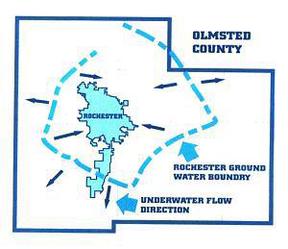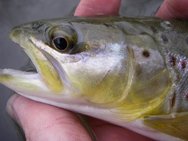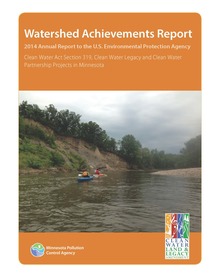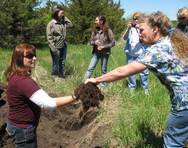|
June 2015
The Basin Alliance for the Lower Mississippi in Minnesota (BALMM) will meet Wednesday, June 17, from 9 a.m. to noon at the Minnesota Pollution Control Agency (MPCA) office, 18 Wood Lake Drive S.E., Rochester.
Agenda as follows:
- 9 a.m. – "Background and Results of the Southeast Minnesota Domestic Well Network." Jim Lundy, Source Water Protection Unit Supervisor, Minnesota Department of Health
-
10 a.m. – Break
-
10:30 a.m. – "Water Sustainability Evaluation for the City of Rochester," Todd Osweiler, Environmental and Regulatory Affairs Coordinator, Rochester Public Utilities
- Noon - Adjourn

A long-time network of volunteers in southeast Minnesota has gathered
important data about nitrates in their well water. Now the network is expanding
to collect additional data, sustaining this effort to better understand our fragile
karst landscape.
The Southeast Minnesota Domestic Well Network builds upon efforts to
develop and implement the Volunteer Nitrate Monitoring Network as a sustainable
means of obtaining long-term trend data for nitrate occurrence in private
drinking water supply wells. From 2006-2012 the project team, including nine
southeastern Minnesota counties and state agency staff, coordinated efforts to
develop a low-cost groundwater monitoring network in Southeast Minnesota that
relies on volunteers to sample their private drinking water supply wells and
send the samples to their county representative for nitrate analysis.
This network was funded by the U.S. Environmental Protection Agency’s Clean
Water Section
319 program and MPCA’s Clean
Water Partnership.
The Southeast Minnesota Water Resources Board completed six years of the
project, which consisted of assembling a network of 675 domestic wells and
enlisting well owners to sample their private drinking water wells.
The project to date has focused on measuring nitrate in groundwater, but
the project goals include sustaining the network as a tool for assessing long-term
trends and as infrastructure for future groundwater sampling projects.
Sustaining and capturing the full potential of the network can occur through
the additional measurements of other analytes, such as major ions, trace
metals, radionuclides, and pollutants. Data generated will be useful to
agricultural chemical management, pollutant studies such as TMDLs, drinking
water quality projects, and others.
Stabilizing and sustaining the network preserves it for future use as
other important study questions arise, and the network serves as a model for
similar studies in other areas of Minnesota and beyond.
Jim Lundy has provided technical assistance and data analysis since the project’s
beginning. At the June 17 BALMM meeting, he will discuss the transition to additional
sampling and how it will lead to a better understanding of our groundwater
resource in southeast Minnesota.
|

The City of Rochester’s current population is about 109,000 and is
expected to grow considerably over the next 20 years. To meet the current needs
of its citizens, businesses and industries, Rochester Public Utilities (RPU) withdraws
about 5 billion gallons of groundwater per year from 32 municipal wells,
primarily from within the St. Peter-Prairie du Chien and Jordan aquifers.
An adequate supply of high quality water is crucial to the economic and
environmental health of the Rochester area. However, there are major gaps in
the understanding of water sustainability and the impact of a changing and
variable climate, for example long-term drought, and a growing population, on
the water system.
RPU and Barr Engineering have been working to evaluate water
sustainability in Rochester. The purpose of the evaluation is to assist RPU in
better understanding the dynamics of groundwater withdrawals and recharge
within the aquifers that provide the city’s water supply, and the impact of the
demands placed on the resource. The goal is to understand what constitutes a
sustainable, high quality municipal water supply for both the near-term and
long-range future.
Todd Osweiler, RPU Environmental and Regulatory Affairs coordinator,
will present information about this evaluation at the June 17 BALMM meeting.
|

An intensive look at waters across Minnesota has found several
concerns, including high levels of nutrients, sediment and bacteria. These
pollutants are all a concern in southeast Minnesota where BALMM and its members
continue their work to identify and solve water quality problems.
The MPCA recently published a report, “Swimmable, Fishable, Fixable?” on general themes so far from the watershed
approach, a systematic look at the health of lakes and streams. The agency
published the report because it has reached the halfway point of examining half
of Minnesota’s 81 major watersheds. So far, the watershed exam
reveals the following themes:
In watersheds dominated by agricultural and urban land,
half or less of the lakes fully support the standard for swimming because of
phosphorus. Excess phosphorus is the main driver of harmful algae in lakes.
Watersheds that are heavily farmed tend to have high
levels of nitrogen, phosphorus and suspended solids in their waters. These
pollutants hurt aquatic life and recreational opportunities.
Bacteria levels in streams are also a problem. Watersheds
where less than half the streams fully support swimming because of bacteria
levels are generally in areas with a higher density of people and livestock —
the developed and agricultural portions of the state.
The vast majority of streams and lakes examined — 97% of
490 stream sections and 95% of 1,214 lakes studied — contain fish tainted by
mercury.
More lakes fully support the swimming standard in the more
forested and wetland-rich areas of north-central and northern Minnesota. The
same goes for streams in areas with lower populations and little animal
agriculture.
The general pattern is that water quality is exceptionally
good in the northeast part of the state and declines moving toward the
southwest.
In a press conference releasing the report, MPCA
Commissioner John Stine noted the long-term commitment needed to restore
Minnesota waters. “We have seen many of these patterns developing over the last
20 years. With the comprehensive watershed information we are gathering, we are
much closer to a diagnosis that can point us toward the changes that need to
happen,” he said. “While the Legacy funds Minnesota citizens invested are
helping us take steps forward, it’s clear that we can’t buy our way to healthy
waters.”
Several media reported on the study, including:
Half of lakes and streams in southern Minnesota found too polluted for safe
swimming, fishing in the
StarTribune
Protecting local
waters: Statewide report highlights both pollution, progress in the Winona
Daily News
Greenspace: PCA report tracks watershed
quality across the state in the Rochester Post-Bulletin
|

Monitoring crews from
the Minnesota Pollution Control Agency are beginning the eighth year of a
10-year effort to assess the condition of rivers, streams and lakes in
Minnesota. This work is being funded by the Clean Water Fund from the
constitutional amendment passed by voters in 2008.
This year’s monitoring
will include the Mississippi-Reno and Mississippi-La Crescent watersheds and
three others bordering the Mississippi River and Iowa in southeast Minnesota
Other teams will work
in the Vermilion River, Cloquet River, Mississippi River-Grand Rapids, Roseau
River, Lac Qui Parle River and Minnesota River Headwaters watersheds. The
monitoring units will also work with Canadian researchers to conduct a survey
of the Red River of the North mainstem, from its source at the confluence of
the Bois de Sioux and Otter Tail Rivers in western Minnesota to its confluence
with Lake Winnipeg in Canada.
The monitoring is
designed to measure and evaluate the condition of rivers and streams by
studying the biology including fish, aquatic invertebrates and plant life as
well as habitat, flow and water chemistry. Examples of aquatic invertebrates
include insect larvae, crayfish, snails, small clams, worms and leeches. Stream
water chemistry is also monitored by MPCA and local partners to provide
information about the quality of the water in which these fish and invertebrates
live and the recreational suitability of the water.
Lake monitoring crews
will sample the larger lakes in the same watersheds. The MPCA and local
partners are committed to monitoring all lakes greater than 500 acres in size,
and as many lakes over 100 acres as possible. The lake monitoring teams will
focus on water clarity, nutrient concentrations and other water chemistry
parameters to assess lakes for their ability to support recreational uses.
In addition to the
watershed work, the monitoring crews will conduct a biological and habitat
survey of 150 randomly-selected rivers and streams across Minnesota. This
survey is part of a national survey of rivers and streams. The data collected
from Minnesota will contribute to the national effort and at the same time
provide critical information to help track long term changes in the condition
of rivers and streams within Minnesota.
To see
monitoring teams in action, you can watch short videos on fish sampling and
invertebrate sampling on the MPCA’s biological monitoring web page. For more
information about these monitoring program activities, visit the MPCA’s water quality condition monitoring web page.
|
 The legacy of farmer Jim Frederick lives on this growing season. He was known as a leader who listened, a business man who knew his economics, and conservationist who practiced what he preached.
Jim was serving as chairperson of the Farmer Led Council in the Whitewater River watershed when he died in December 2014. The council was the first of its kind in Minnesota, an effort that took fortitude to get off the ground and running. With a knack for befriending people and organizing projects, Jim was the ideal person to lead the effort.
He was born in 1945 in Rochester, graduated from St. Charles High School, and attended the University of Minnesota Business School. He spent most of his career working at HCC in Mendota, Ill.
In 1998, Jim and his wife Rae moved back to St. Charles to his family farm where they grew corn, soybeans, alfalfa and beef cattle with conservation practices like crop rotation, grass waterways and fertilizer management. In fact, Jim was the first farmer in Olmsted County to receive certification in a volunteer water quality program with the Minnesota Dept. of Agriculture.
When the Farmer Led Council first was being organized, Jim noted that County Road 10 in Olmsted County was having some erosion issues due to highway construction work. He and Jerry Hildebrandt, conservationist at the time for the Whitewater Watershed Project, contacted the Olmsted County Highway Department and met with the county engineer. The three drove the entire reconstructed road, identifying areas that the county should fix.
"Jim’s rationale was that conservation responsibility does not rest only with the farmers. We all need to play a role," Jerry said. "Jim was not only able to explain to others what can be done in conservation farming, but he followed it himself. He did recognize that there are great challenges to farming this area, but much can be done to farm in a manner that improves the watershed."
Read the full tribute to Jim on the MPCA website.
|
 The lakes and streams in southwest Minnesota made headlines this spring after the MPCA reported that few of the lakes and streams there were fully meeting swimmable and fishable standards. Behind the headlines are hundreds of projects on the front lines of restoring and protecting water quality. Local partners like watershed groups and SWCDs usually carry out these projects.
Every year the MPCA publishes a report on projects funded by the Clean Water Section 319 and Clean Water Partnership programs. The 2014 report was recently posted on the agency website. Project examples include:
- With the goal to reduce bacteria in the Rock River in southwest Minnesota, the Rock County SWCD worked with producers to calibrate manure application equipment, implement manure management plans, and attend educational events.
- In southeast Minnesota, several counties continued their efforts to help small feedlots reduce their runoff – and bacteria in it. The most recent project resulted in technical assistance to more than 25 producers, along with financial and technical help to fix runoff problems at 40 feedlots.
- In the metro area, the Shingle Creek Watershed Management Commission studied whether porous pavement would reduce stormwater pollution while holding up to city traffic in Robbinsdale. The results indicated that porous asphalt may be a useful de-icing substitute for road salt. In addition, the porous asphalt withstood three winters of snowplowing and freeze-thaw cycles with minimal impact. If built over a sand layer, the porous pavement section resulted in 100-percent removal of pollutants and runoff volume.
For more information, visit the Watershed Achievements Report webpage.
|
 About 50 women farm land owners attended Women Caring for the Land workshops to network and learn about soil conservation from experts at three field days, May 20-22 in Cold Spring, Melrose, and Buffalo. They learned ways to assess and improve the health of soils through cover crops, no-till and strip-till, and other conservation practices, and learned about resources and assistance in reaching conservation goals. According to a study in Iowa, nearly half of its farmland is owned by women. The U.S. Census Bureau reports that in 2012, 14 percent of the nation's 2.1 million farms had a female principal operator.
On a farm near Melrose, U of M Extension soil expert Jodi DeJong-Hughes hopped down into a soil pit to show healthy and degraded characteristics of soil. “Every soil pit I jump into it’s a very different story,” she says. Healthy soil has high organic matter and teems with microbes. “Tilling soil is like opening a big wound.”
Women Caring for the Land is facilitated by the Women, Food and Agriculture Network and Renewing the Countryside, and hosted by Stearns County SWCD, Buffalo NRCS, Minnesota Department of Agriculture, U of MN Extension, and Sustainable Farming Association. The workshops were made possible with support from USDA North Central region Sustainable Agriculture Research and Education and the McKnight Foundation. Photo: Jodi DeJong-Hughes holds out a clump of healthy soil in Stearns County.
|
The Minnesota Department of Agriculture announced three new projects funded through their 2015 Clean Water Fund Request for Proposals:
-
Assessment of rate and timing of phosphorus application in corn-soybean rotations on the potential for phosphorus loss to surface waters and tile. Project Leader: Daniel Kaiser- University of Minnesota, Soil, Water and Climate. $224,773 over 3 1/4 years.
-
Measuring and modeling watershed phosphorus loss and transport for improved management of agricultural landscapes. Project Leader: Jacques Finlay-University of Minnesota, Ecology, Evolution and Behavior. $297,419 over three years.
-
Agricultural Best Management Practices (BMP) handbook for Minnesota update. Project Leader: Chris Lenhart-University of Minnesota, Bioproducts and Biosystems Engineering. $65,600 over 1 3/4 years.
A total of 11 projects were submitted totaling $2.25 million in requested funds. The evaluation committee recommended the top three projects to be funded this year. All projects start this spring. More information about research projects supported with Clean Water Fund dollars (including project descriptions, results and reports) is available at www.mda.state.mn.us/research.
|